Talking to a robot sounds fun in theory—or slightly terrifying if, like me, you’ve seen one too many sci-fi movies. But in practice, the hurdle is (usually) less about ominously glowing red eyes and more about figuring out how to actually put those conversations to good use.
Chatbots have been around for years, but with the rise of AI, they’ve gotten smarter, more capable, and way more useful across a variety of roles—especially when you combine them with automation. Whether you’re in marketing, HR, customer support, or just tired of copy-pasting the same response for the fifth time today, there’s probably a chatbot use case with your name on it.
In this guide, I’ll walk through real-world examples of how businesses are using chatbots today, plus ideas for how you can put them to work in your own workflows.
Skip ahead
What is a chatbot?
A chatbot is a software application designed to simulate conversation with human users, often powered by rules, machine learning, or AI. You’ve likely already met a few—think of the support bot that helps you reset your password at midnight or the AI concierge that walks you through booking a demo without making you fill out a form from the ’90s.
Chatbots live in places where you already are: your website, Slack, Facebook Messenger, WhatsApp, or even right inside your product. They’re built to save time: yours and your users’. Instead of hunting for answers, your audience (or team) gets instant help.
Of course, not all chatbots are created equal. Some follow simple decision trees (press 1 for billing, press 2 for support), while others are full-blown AI-powered assistants capable of pulling in real-time data, making recommendations, or even cracking a joke. And when you connect them with Zapier, they can even trigger actions inside the rest of your tools.
Chatbots vs. agents
Chatbots and agents often get lumped together, but they actually play very different roles.
Chatbots are your classic rule-followers. After being trained on a data source (like your website contents or knowledge base), they’re great at structured tasks like answering FAQs or helping customers navigate your site.
Agents, on the other hand, are the new kids on the block—and they’re much more capable. Beyond just responding to inputs, AI agents can reason, plan, and take action on your behalf. They can handle multi-step workflows, make decisions based on changing inputs, and even collaborate with other agents to get the job done.
|
Chatbots |
Agents |
|
|---|---|---|
|
Primary function |
Respond to messages or inputs |
Complete multi-step goals and tasks |
|
Core strength |
Conversation |
Automation and action |
|
Level of intelligence |
Rule-based or AI-powered, but reactive |
Reasoning, planning, and autonomous decision-making |
|
Task complexity |
Handles simple, repetitive tasks |
Handles complex, evolving workflows |
|
Context awareness |
Limited to current interaction |
Maintains context across tasks and time |
|
Examples |
Answering FAQs, routing tickets, collecting basic info |
Onboarding new hires, qualifying leads, managing project tasks |
|
Zapier use case |
Connect a chatbot to thousands of apps with Zaps to trigger actions |
Use AI Agents to autonomously complete work across your tools |
|
User interaction |
Always user-initiated |
Can be initiated by a user or another trigger, and operates independently |
Where Zapier fits in
Zapier makes both chatbots and agents smarter and more useful.
-
You can connect Zapier Chatbots with over 8,000+ apps via Zaps. That means your chatbot can not only talk, but do things—like log lead data in your CRM, trigger a task in Asana, or update a Google Sheet.
-
Zapier’s AI Agents platform takes things to the next level. These agents can reason over goals, interact with your apps, and handle complex tasks like onboarding a new employee, triaging a support backlog, or following up with leads across multiple platforms (without you lifting a finger).
In short: chatbots are great for conversations and agents are built for actions. With Zapier, you can have both working side by side—chatbot in the front, agent party in the back (the only mullet I can support).
Zapier is the most connected AI orchestration platform—integrating with thousands of apps from partners like Google, Salesforce, and Microsoft. Use interfaces, data tables, and logic to build secure, automated, AI-powered systems for your business-critical workflows across your organization’s technology stack. Learn more.
Types of chatbots
The term “chatbot” is often used as a catch-all, but there are several distinct types, each built with different capabilities in mind. Understanding the difference can help you choose the right one for your use case, whether you’re offering basic support or building a fully personalized customer experience.
Menu- or button-based chatbots
These are the most straightforward type of chatbot. They guide users through a series of preset options (usually buttons or quick replies) so the interaction stays tightly structured. These bots are great for simple tasks like answering FAQs or routing requests to the right team.
Rule-based chatbots
Also known as decision-tree bots, these rely on a defined set of rules and keywords. When a user types something, the bot matches it to a pre-written rule and delivers a corresponding response. They’re efficient for handling predictable, repetitive questions—but they can struggle when the input doesn’t match what they were trained to expect.
AI-powered chatbots
These bots use artificial intelligence and natural language processing (NLP) to understand and respond to a broader range of user inputs. Instead of matching keywords, they interpret intent and context. That makes them more adaptable and capable of handling nuanced or unexpected questions.
Generative AI chatbots
These represent the most advanced class of chatbot. Built on large language models (LLMs), generative AI chatbots don’t just retrieve pre-written answers—they generate responses on the fly based on what the user says. They’re ideal for delivering personalized, dynamic experiences and can even take on tasks like summarizing information or composing emails.
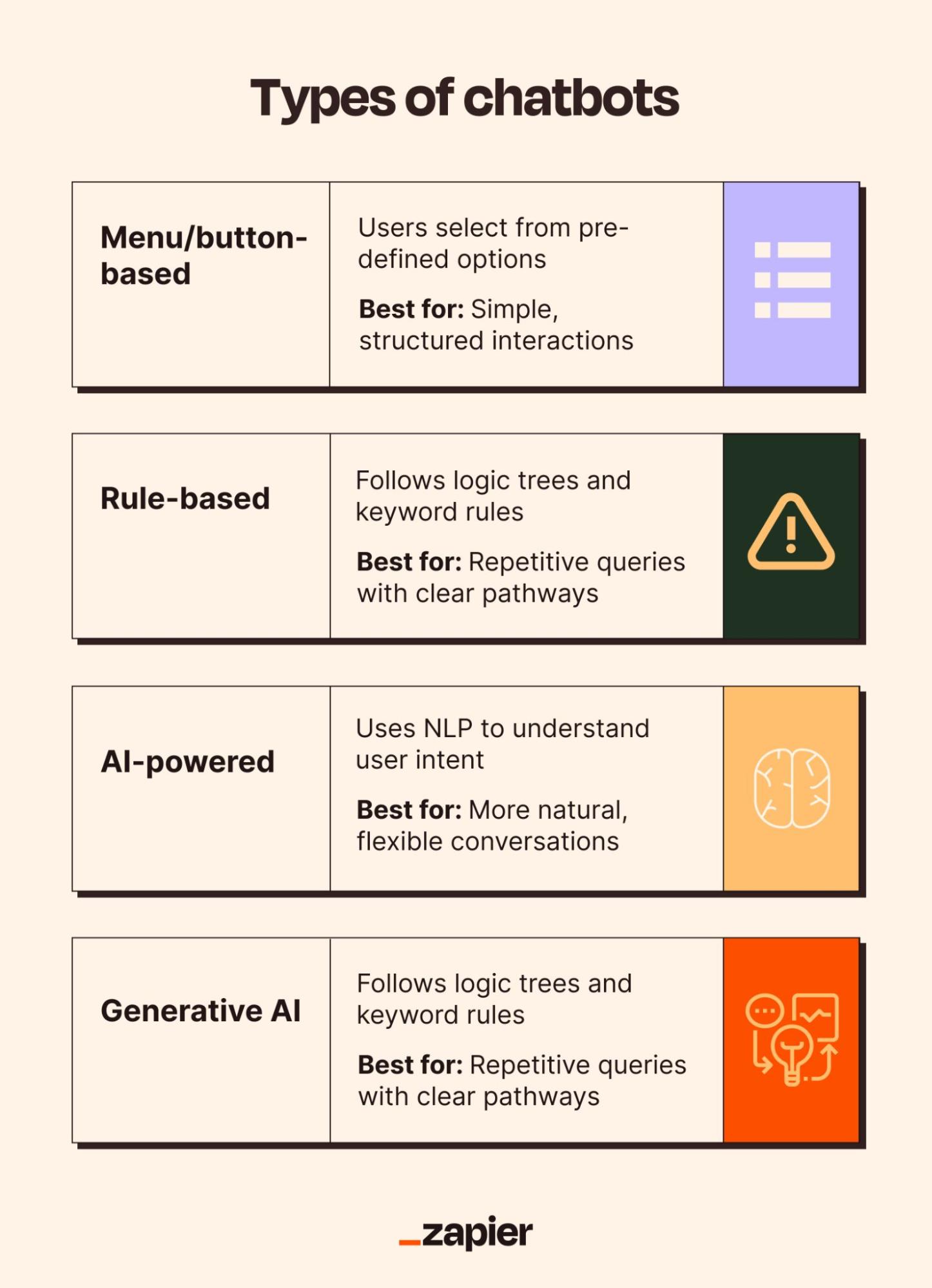
6 chatbot use cases
Here are a few ways real Zapier users are putting chatbots to work for their business, across support, sales, marketing, HR, and IT.
Chatbots for customer support
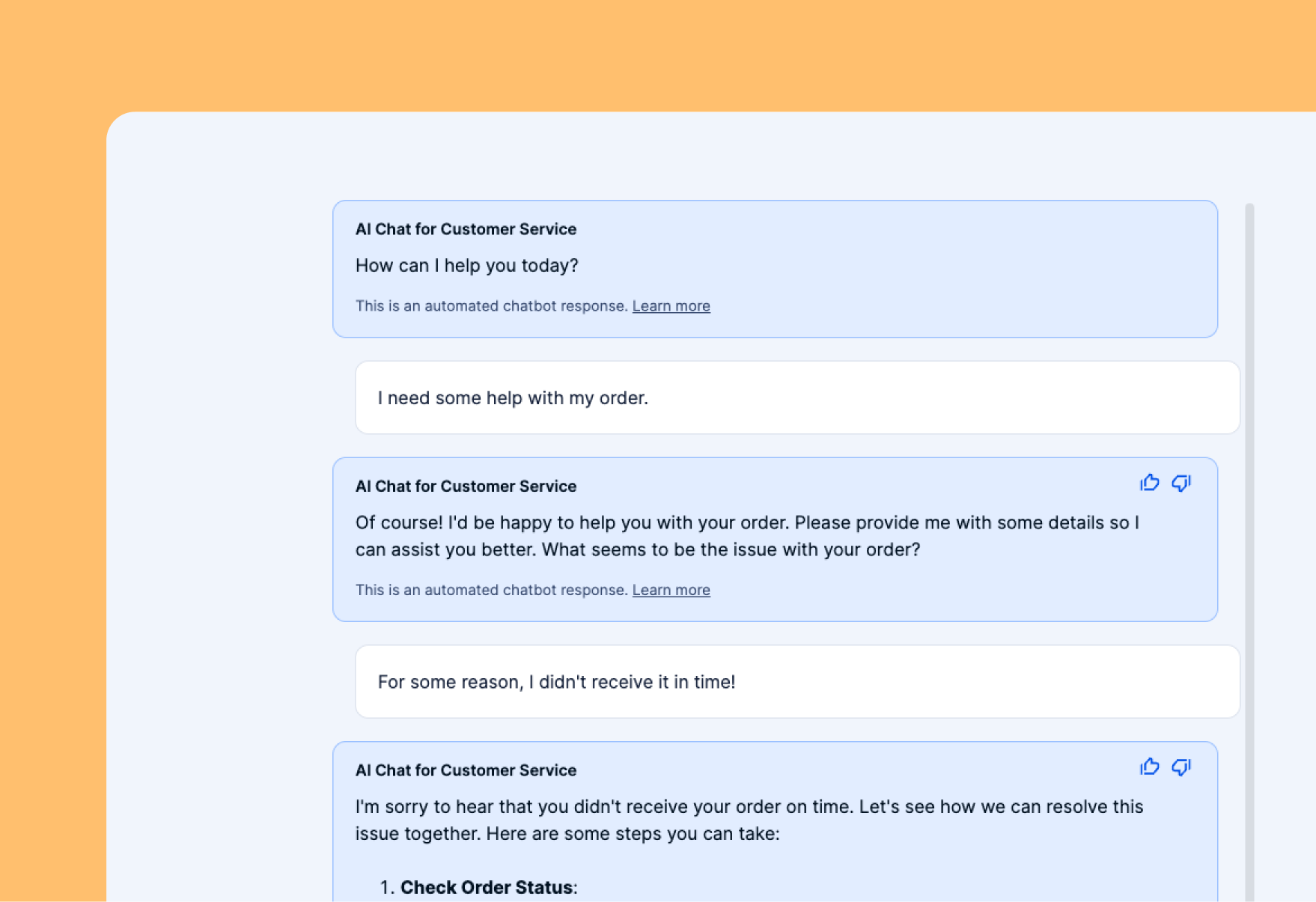
Customer expectations have shifted: People want answers quickly, and they don’t want to dig through help docs to find them. Chatbots make it possible to meet those expectations without overloading your support team.
For example, online learning platform Learn It Live‘s small team was overwhelmed with support requests. Repetitive questions were eating into valuable time, so they embedded an AI-powered chatbot on their website to handle common inquiries. With Zapier Tables powering a dynamic knowledge base, the bot could provide real-time, accurate responses. And when an issue needed a human, the bot triggered a Slack notification or logged a support ticket automatically. As a result, Learn It Live saw a 40% reduction in support tickets, happier users, and fewer distractions for the team.
Zapier Chatbots are often used this way: always-on, first-line support that can tailor responses based on what the user is asking. Whether someone needs help resetting a password, understanding a billing policy, or checking the status of an order, the chatbot can respond with relevant, helpful information—no support ticket required. That not only improves the customer experience but also frees up your team to focus on higher-priority issues.
And with Zapier handling the automation behind the scenes, your chatbot can escalate complex questions, log conversations in your support tools, or even trigger follow-up workflows when needed.
Learn more about how to create an AI chatbot for customer service, or get started with these pre-built templates.
AI Chat for Customer Service Template
Resolve customer questions and reduce support volume with a customized chatbot.
Simple FAQ AI Chatbot Template
Supercharge your customer support with an OpenAI-Powered FAQ chatbot.
Chatbots for marketing
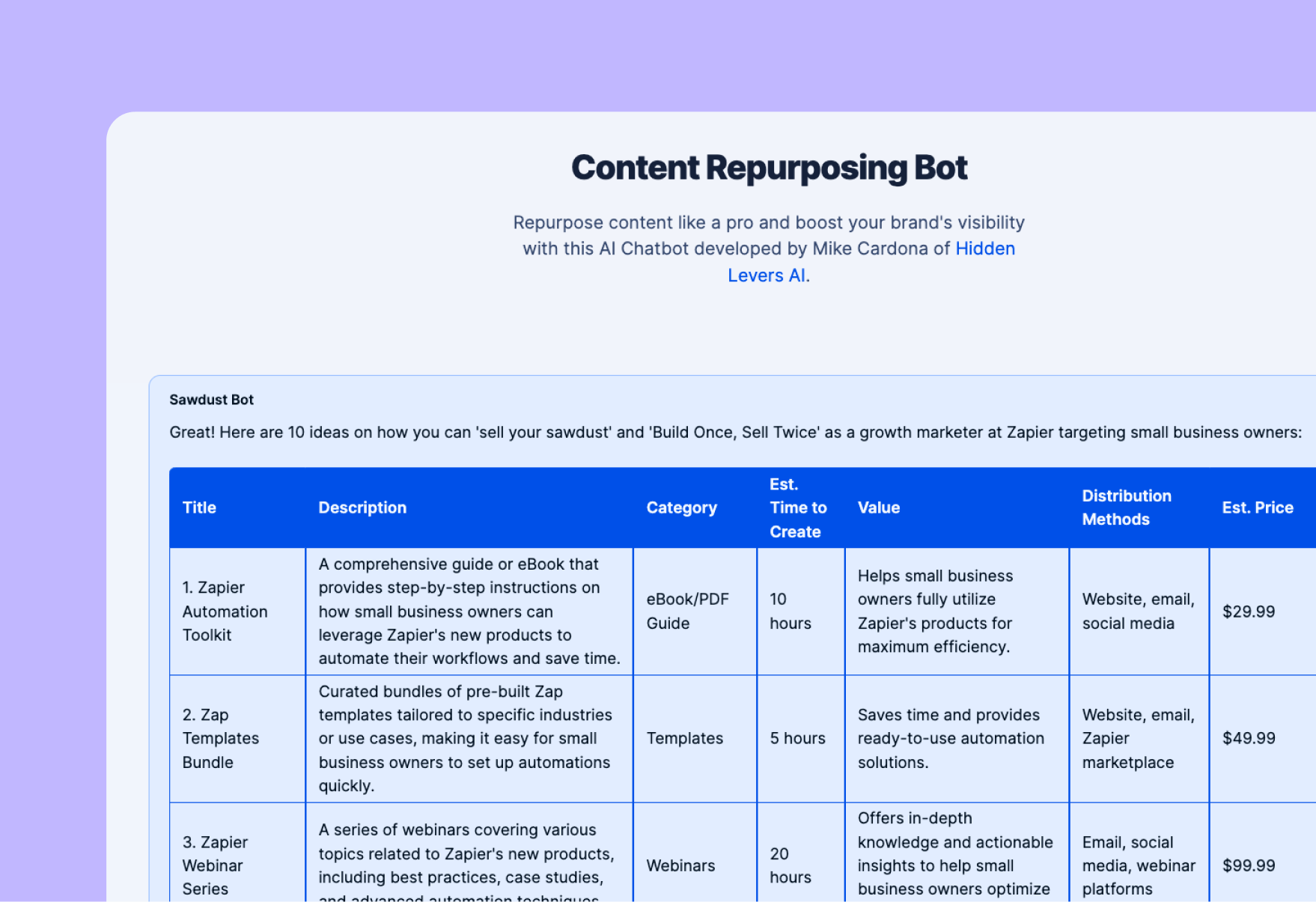
Marketing teams juggle a lot—lead generation, content distribution, campaign planning, and more. Chatbots help lighten that load. For example, if you’re struggling to keep up with social media content, an AI-powered chatbot can help you brainstorm post ideas, write captions, and generate variations tailored to different platforms. That means fewer creative bottlenecks and more consistent output.
Social Media AI Chatbot Template
Generate posts and streamline your social media strategy with this chatbot, powered by OpenAI.
Or, if you have a library of high-performing blog posts, newsletters, or other assets, a chatbot can help you unlock more value from them. By connecting to your existing content database, a generative AI chatbot can repackage content into new formats, like turning a blog post into a LinkedIn post or summarizing a webinar into an email draft.
Content Repurposing AI Chatbot Template
Repurpose existing content with a list of digital marketing ideas, powered by OpenAI.
Read more: What is chatbot marketing? Benefits, use cases, and strategies
Chatbots for sales and lead generation

Sales teams succeed when they can focus on real conversations with qualified prospects—not chasing cold leads or sorting through contact forms. Chatbots help by doing the early legwork: engaging visitors, collecting key details, and handing off hot leads to the right rep at the right time.
Chatbots can greet visitors on your site or landing page and ask the kinds of questions that help qualify interest—things like company size, budget, timeline, or pain points. Unlike static forms, bots feel more natural and conversational, which often results in higher-quality responses.
Because chatbots operate in real time, they can surface leads to your sales team the moment interest is expressed. Once someone is qualified, the bot can route them to the appropriate next step, whether that’s scheduling a call or passing their info to the CRM.
With automation layered in, a chatbot can:
-
Add contact and conversation details to your CRM
-
Trigger lead scoring workflows
-
Notify sales via email or Slack in real time
-
Enroll qualified leads into a nurture sequence or sales pipeline
-
Personalize the buyer journey
Chatbots can also provide tailored product recommendations, pricing details, or demo scheduling links based on what a visitor asks. The experience feels personalized, but it’s automated—so your team can scale outreach without sacrificing quality.
That was the case for Results Grow, a service-based business that was losing hundreds of leads due to slow follow-up. Field workers were handling both client jobs and sales outreach, and there simply wasn’t time to do both well. By adding a chatbot powered by ChatGPT and Zapier Tables, they automated lead engagement and appointment booking. The bot responded immediately to inquiries, maintained context throughout the conversation, and guided prospects to book a consultation. It helped the team reclaim lost opportunities and bring in more than $134,000 of annual revenue.
Learn how to build your own AI chatbot that captures leads, or get started with these pre-built templates.
AI Chat for Lead Generation Template
Increase lead engagement with a conversational chat experience embedded on your website.
Chatbots for HR
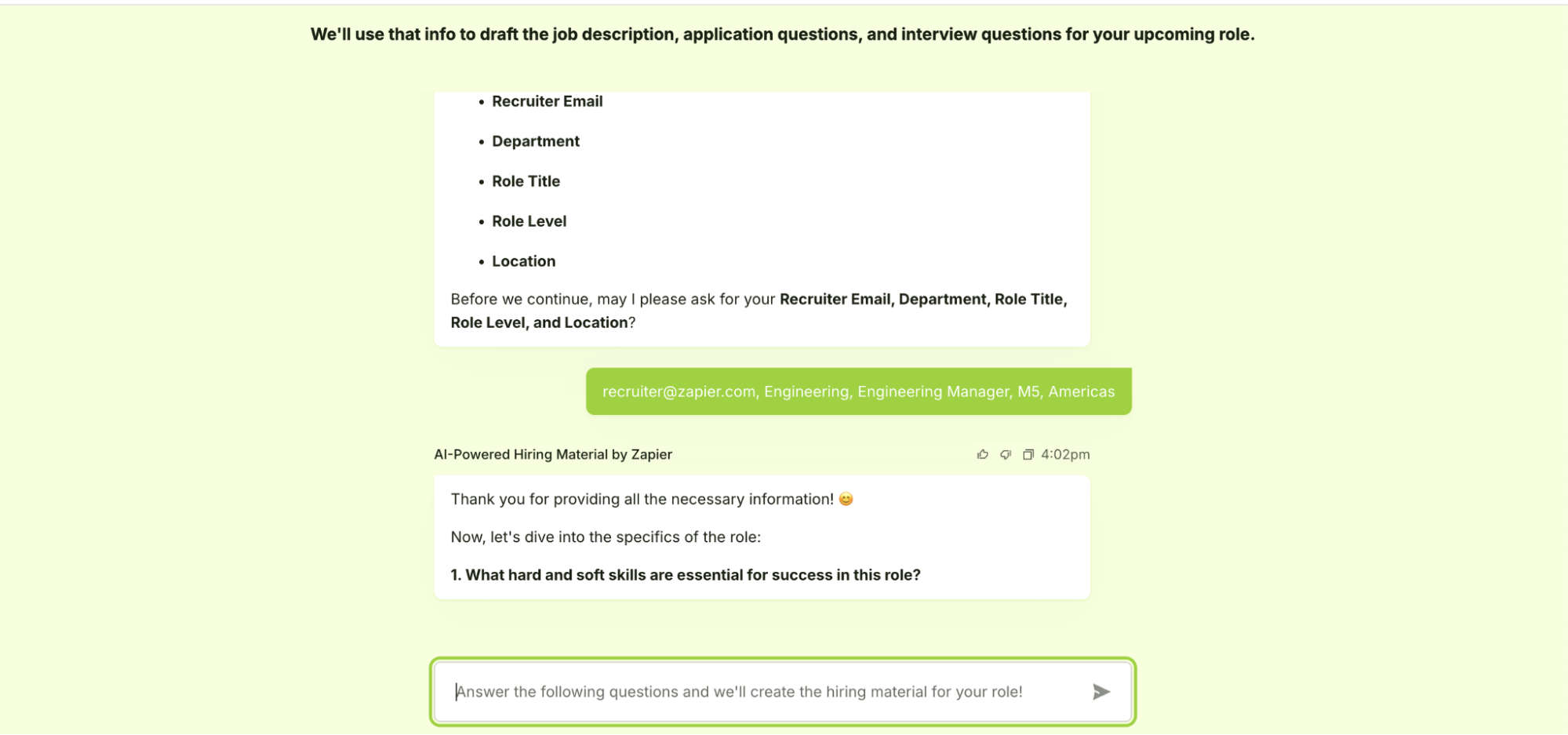
HR teams often juggle a wide range of responsibilities—recruiting, onboarding, internal comms—and chatbots help streamline many of those workflows. They act as an always-on assistant, whether you’re launching a hiring process or helping a new employee get up to speed.
For hiring, a chatbot can capture insights from hiring managers and turn them into job descriptions, interview questions, and candidate-facing materials, all while pulling from your company’s internal knowledge base. That helps teams launch roles faster and ensure a consistent experience for every candidate.
AI-powered hiring material
Make kicking off hiring a breeze with AI-generated job descriptions, application questions, and interview guides.
On the onboarding side, chatbots help new employees navigate their first days without bombarding HR with questions. By connecting to internal documentation, a chatbot can deliver clear, accurate answers to common onboarding questions, like how to access tools, where to find company policies, or what to expect in week one. It’s a scalable way to support new hires while keeping HR focused on the human side of the job.
Employee onboarding AI Chatbot Template
Empower your HR team with an OpenAI-powered chatbot for a seamless onboarding experience.
Chatbots for IT
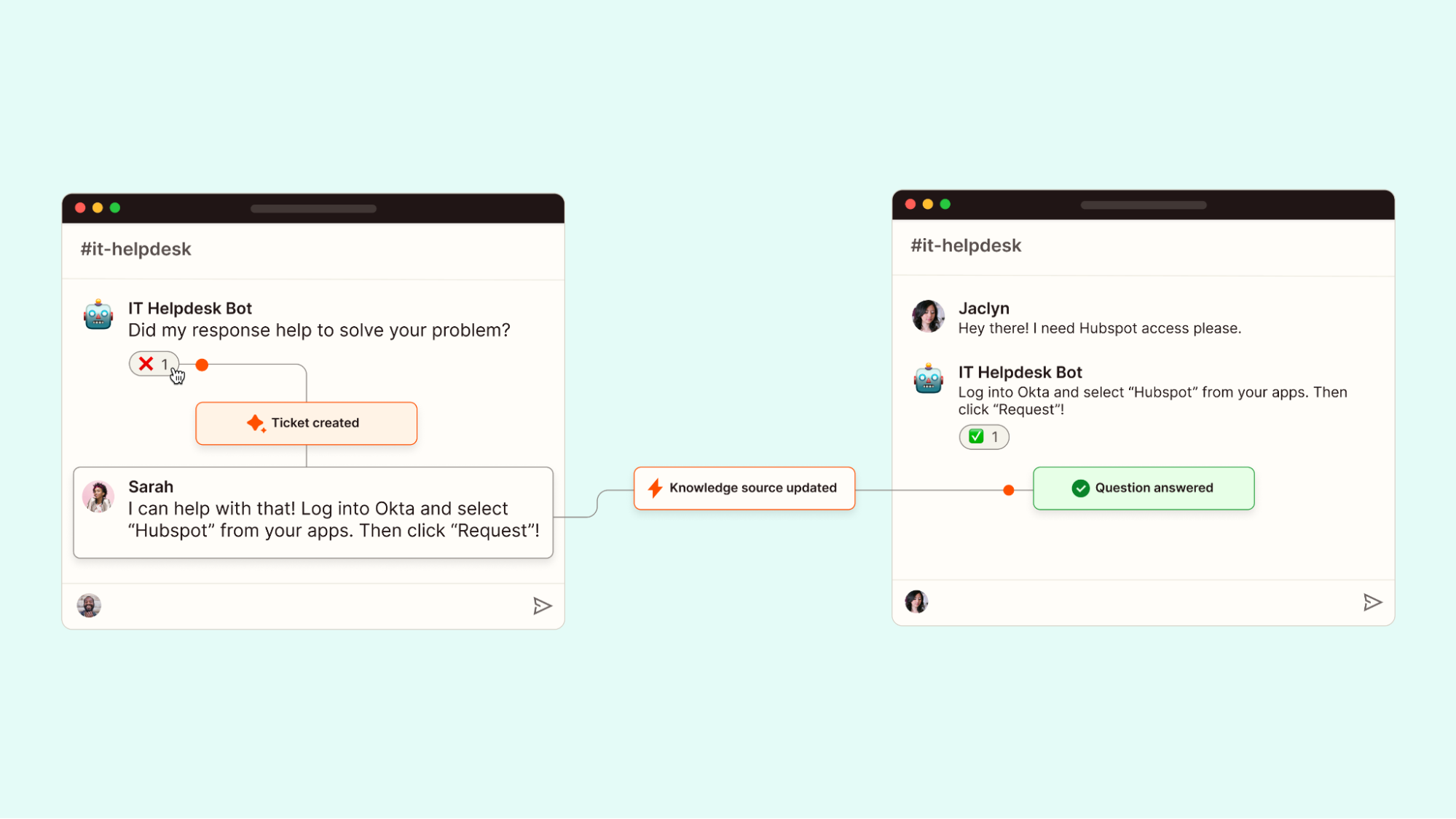
Answering the same “How do I reset my password?” or “Where can I find the VPN instructions?” questions every day can drain most IT professionals of the will to log into their work computers. By embedding a chatbot into your internal help desk or support portal, IT can automate responses to routine requests and free up time for more strategic (and less hair-pulling) work. Employees get immediate answers to common issues, while more complex problems are prioritized and routed to a human without getting buried in a ticket backlog.
Some IT chatbots even go a step further by learning from interactions over time, building up a smarter internal knowledge base with each conversation. It’s an efficient way to support your team—and reduce the volume of tickets that never really needed human intervention in the first place.
Give it a try for yourself with this pre-built template.
IT help desk
Improve your IT support with AI-powered responses, automatic ticket prioritization, and knowledge base updates.
Chatbot ideas by industry
Still looking for inspiration? Here are some practical ways different industries are using chatbots (paired with their own knowledge bases) to streamline operations and engage users:
|
Industry |
Example chatbot use cases |
|---|---|
|
eCommerce |
Recommend products based on preferences Answer shipping and return questions Track orders Collect post-purchase feedback |
|
Healthcare |
Pre-screen patients Schedule/reschedule appointments Answer FAQs about insurance or billing Send medication reminders |
|
Human resources |
Assist with job applications Answer benefits or PTO questions Guide onboarding Collect employee feedback |
|
Education |
Answer enrollment or course questions Share study resources Register users for events Offer tutoring or support |
|
Real estate |
Qualify buyers/renters Share listings based on criteria Book property showings Provide financing guidance |
|
Finance & banking |
Share account balances or due dates Answer loan/credit FAQs Route fraud alerts Offer financial education content |
|
SaaS & tech |
Troubleshoot product issues Suggest help docs or tutorials Qualify sales leads Collect product feedback |
How will you use chatbots?
When you build your bots with Zapier, you’re plugging into the most connected AI orchestration platform out there—which means you can go beyond simply setting up a chat tool. Your chatbot can instantly trigger workflows across 8,000+ apps, turning simple conversations into powerful, automated systems.
As it turns out, talking to a robot can be fun (and useful), especially when it helps you automate repetitive work, streamline communication, and deliver a better experience for customers and teams alike. Just take my advice and avoid reading any Asimov novels while you’re at it.